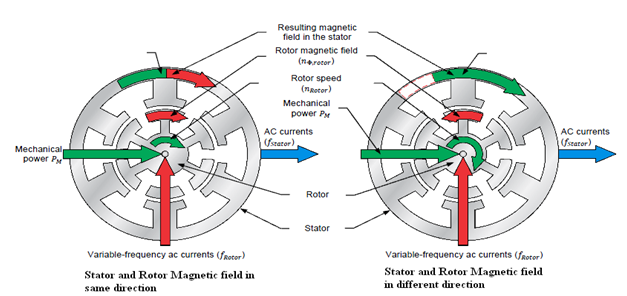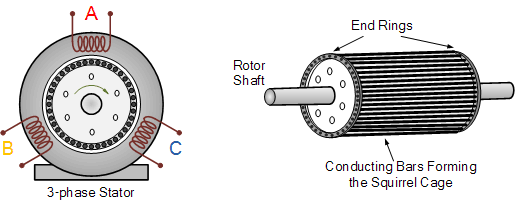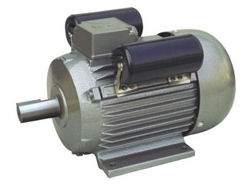Induction generator
Asynchronous generators are in electrical power engineering asynchronous machines, which are operated as a generator. They are used among other things in decentralized small power plants for economic reasons instead of synchronous generators to produce electricity. Furthermore, asynchronous come as so-called supplementary or auxiliary generators.
- 3.1 Direct grid connection
- 3.2 Umrichterkopplung 3.2.1 cycloconverter
- 3.2.2 Inverter with DC
- 5.1 advantages
- 5.2 disadvantages
- 6.1 Examples of use
Basics
Each phase machine can be used both as a motor and as a generator. For use as a generator, the induction must be magnetically energized and mechanically driven. If asynchronous motors driven faster than the rotation frequency of the rotating field, they operate as a generator and feed active power into the grid. This can occur, for example when driving downhill of passenger elevators, conveyors and cranes. This effect is referred to as regenerative braking. For pole-changing machines with switching from high speed to low speed ( or vice versa), there are additional requirements to ensure that no undue spikes can occur based on current or mechanical load. The goal is to feed the braking energy in generator mode into the net. If asynchronous motors powered by a drive control (frequency converter), it must be capable of regenerative feedback. This means that the frequency converter must allow a true four-quadrant operation.
Design and function
As a classic three-phase asynchronous induction generators come with squirrel-cage rotor for use. They are much simpler than other asynchronous. The most common asynchronous generators have 4 poles. This requires the rotating field speed is only 1500 rpm -1. To achieve Drehzahlstufung and thus a softer network interconnection, stand with pole-changing windings are used in certain areas. This is achieved with the asynchronous generator in the entire power range optimal energy yield.
The rotor is designed as a round bar runners. In addition to using normal industrial motors, induction motors, special use for the generator to be built. This asynchronous generators have to achieve rotor bars of copper at a higher efficiency. They are also due to a better quality sheet metal ( low-loss magnetic laminations for the stator and rotor ), specifically for use as a generator designed and optimized.
Decisive for the performance of the asynchronous machine the dependence of the torque M of the speed is n This dependence can be seen from the torque - speed characteristic of the induction machine. Work on the generator shaft additional forces a so increases the slip, this in turn results in an increase of the electric power emission. The difference between full throttle and idle speed is in practice very small. The difference to the synchronous speed is given in percentage and denotes the generator's slip, it is around 1 percent. This means for a four- pole machine, that they with 1515 min - 1 is running at full load operation.
Since induction machines can be operated under both synchronously and synchronously over, the following relationship is valid for a four -pole machine:
Because at super-synchronous operation, the rotor speed is higher than the rotating field speed, the rotor frequency is higher than the field frequency. Thus, in the bars of the rotor in each case a voltage is induced. Since the rods are mutually spatially offset, is a phase shift between the respective voltages of the individual rods. Thus in the rotor a multi-phase voltage is effective. When the slider eg 25 bars, 25 -phase AC voltages are effective. As the rotor bars are connected at the end sides of the rotor each have short-circuit rings, flowing a multi-phase alternating current. At 25 bars thus flows a 25 phase alternating current.
Around the rotor causes the multi-phase alternating current produced a rotor rotating field, the exact same number of poles as that of the exciting stator rotating field, as the squirrel cage rotor automatically adapts to the number of poles of the stator. For this reason, this runner can be used for a variety of pin counts. However, this rotor rotating field rotates counter to the rotational direction of the rotor. However, the rotor speed box retains its position relative to the stator rotating field at constant because the rotor rotates faster than the stator rotating field. The prerequisite is that the driving power is the same. The rotor rotating field is offset by the load angle λ relative to the stator rotating field. The asynchronous induced in the stator winding a voltage.
Efficiency
In generators to be operated at a high duty cycle, the efficiency of the machine is very important. The efficiency of the generator is substantially influenced by three factors, the copper loss, iron loss and the friction loss. For generators that are operated for long periods at part load operation, a good part load efficiency is also important. The load-dependent additional losses usually amount to 0.5 percent of the rated power output. Design measures, the efficiency η of the generator to optimize. This optimum is depending on performance in asynchronous at around 90 percent.
Power factor
The power factor cos φ is load-dependent asynchronous generator. This affects especially if the machine has a small pull-out torque. The power factor is a measure of the quality of the machine. This means that in a given operating point of the generator machine current is also greater with increasing reactive power requirement. The larger machines current in turn leads to greater losses. In the partial load range deterioration of the power factor leads to a relative deterioration of the loss balance of the machine. Therefore, already at attention in machine design in advance whether the generator has to work in extreme partial load range for a long time. By leistungsumschaltbare stator windings can the required magnetization of the machine, to adapt. By this measure, the required reactive power requirement of active power actually delivered is adjusted quasi already on the generator side. The optimum machine side power factor is modern asynchronous 0.87.
Magnetic excitation
The three phase asynchronous motor is not able to attract even magnetic. This has been the cause in the fact that the direction of the inductive reactive component between the motor and generator operation remains unchanged. For this reason, it is the asynchronous generator also not possible regenerative feed it into a loaded only with inductive or ohmic resistors network. Ohmic and inductive resistances can not provide the required inductive current, which serves as a magnetizing current in this case. The necessary excitation of the induction generator can be done through the following measures:
- Separate excitation
- Capacitor excitation
The external excitation is done by connecting to a powered AC synchronous generators, synchronous generators can provide the necessary inductive reactive current. One calls this circuit then a grid -excited induction generator. The capacitor excitation is provided by the parallel connection of capacitors to the stator winding. One calls this circuit then a capacitor -excited or self-excited induction generator.
Manic asynchronous network
With network- excited induction generator, the stator is taken from the mains supply the required reactive power to the magnetic field structure. For this purpose, it is necessary that other generators operate as a phase shifter, and provide the required reactive power. Is driven in synchronism with the rotor, it is called this a negative slip. In the rotor, the electromotive force -U02 is formed. It flows the rotor current I2. This rotor current in turn causes the rotor field, which runs counter to slip due to the negative of the mechanical rotation. The consequence of this is that asynchronous active power fed into the grid. The fed into the grid active power increases with the increase in the super-synchronous speed. The grid frequency is determined by the connected synchronous generators.
Capacitor -excited induction generator
The capacitor -excited asynchronous parallel connection of stator coil and the capacitor forming a resonant circuit. Remember to include in the rotor iron still a part of residual magnetism. Is there no remanence present, the rotor iron on a battery needs to be biased. A corresponding power electronics is required. With the aid of the resonance circuit of the magnetic flux is established in the stator circuit. If the capacitors sized according to the desired electromotive force is generated. The asynchronous working here without power supply from the mains. The capacitors can be connected either in star or in delta. However, it has been proven in practice that the capacitors are connected in delta.
Since the frequency is not strongly influenced asynchronous generator, it is another parameter, in this case, the voltage must be kept constant. When the asynchronous generator voltage is speed- dependent and must be kept constant over a control. This is done by controlling the speed. To keep the voltage constant, the rotational speed between idling and full load, has to be changed. Any resultant frequency fluctuations are of no practical significance.
Operation
If the rotor is driven, the resonant circuit of the main coil and condenser by the remanence of the runners packet is encouraged to reach a stable operating point. In the asynchronous load requires additional reactive power. The increasing reactive current component of the stator current must be provided from the capacitor reactive power. The reactive power of the capacitor is often not enough at higher load in order to meet the need of the asynchronous generator of reactive power magnetization. In this case, the generator is de-energized. This load dependence of the terminal voltage is under ohmic -inductive load greater than with pure resistive load. The reason is that in ohmic-inductive load, the available magnetization current is reduced by the inductive reactive power demand of the load.
To reduce the load-dependent voltage drop excitation capacitors can be used, which can be adjusted in steps instead of fixed capacitors. However, this may lead to voltage spikes during switching of the capacitors. An equally good option for voltage stability improvement is the use of saturable reactors. In this case, inductors are connected in parallel to the capacitors. , The iron core of the choke coil is designed so that it becomes saturated at a low magnetic flux density. This saturable reactors bridge the capacitors partially when the induced voltage rises too high. This will weaken the excitation and hence the voltage.
Grid connection
An asynchronous generator is very easy to lock onto an existing network. Unlike the synchronous generator synchronization is easily asynchronous generator. There are two options for network connectivity:
- Direct grid connection
- Umrichterkopplung
Direct grid connection
Asynchronous generators can be connected without any special precautions on power, this is called direct or rigid network coupling. This intrusion can take place both in standstill, at any speed. The asynchronous machine pulls the entire machine set automatically " kick in ". Due to the slip, a softer coupling results to the grid. When switched on failure of the prime mover to the power of asynchronous left, he continues as a motor and consumes energy from the grid ( reverse power ). The effect is used in some asynchronous eg in cogeneration plants or certain early wind turbines as starting aid. This variant of the network coupling was, for example, in wind turbines of the so-called " Danish concept ", due to its simplicity in the 1980s and partly the 1990s often were used widely. In the 1990s, more and more wind turbines put to use by the cascade machines and feed some of the power via the inverter, so that this concept is no longer used due to various disadvantages.
Umrichterkopplung
It is advantageous if the asynchronous generator is connected via converters to the network is. For asynchronous two converter types are used:
- Cycloconverter
- Inverter with DC link
Cycloconverter
In this inverter input and output are directly without an intermediate circuit using semiconductor valves, such as thyristors, connected to each other. Of the three voltages of the three-phase network of three approximately sinusoidal voltages are generated. Even though the output frequency is variable, but it is smaller than the input frequency. Due to the extensive power section require a complicated control cycloconverter. For this reason, they are rarely used despite their high efficiency with asynchronous generators.
Inverter with DC link
When the network connection with indirect converter is between asynchronous and a pulse inverter power, namely an IGBT inverter, connected. The stator winding of the asynchronous generator is connected to the power converter system. The output of the inverter fed via an LC filter in the three-phase network. The power converter system consists of:
- LC filter
- Pulse rectifier
- DC voltage intermediate circuit
- Pulse inverter.
By a fourth pulse inverter bridge arm, it is possible to generate a four-phase network with neutral. Here, the inverter is controlled so that the phase voltages form a symmetrical three-phase system. Through a microcontroller -controlled IGBT inverter can extend the operational range of the plant to the grid. In addition, there is also a high-quality stand-alone operation can obtain.
Additional reactive power compensation
Since network excited induction generators weigh heavily on the network by the required reactive power demand, it is often necessary to generate an additional reactive power compensation using capacitors after consultation with the local electricity company. Through a parallel-connected capacitor bank, the generator reactive power is compensated at 90 %, this corresponds to a cos φ of 0.96. A larger compensation is simple capacitors difficult to implement, since the resonant frequency of the resonant circuit may result in closer to grid frequency harmonics, which in turn would result in mechanical vibrations. In addition, a high harmonic content has an adverse effect on connected electronic consumer.
In addition, it should be noted that the self-excitation limit may be exceeded. This means that the generator generates a voltage is turned off, despite the network. This self-excitation occurs when the capacitors are too large in size. Without load increases with increasing voltage and the frequency at the generator terminals. Another problem occurs when with increasing idling speed of the generator is self-excited, although the compensation capacitors are such that under rated operating conditions, the self-oscillation limit is exceeded. In order to avoid any damage in compensated systems, these systems are equipped with additional safety devices, these are:
- Frequency monitoring ( today / - 1 Hz possible)
- Voltage monitor
- Phase angle error measurement
- Circuit-breaker lock with the compensation system
- Automatic compensation system
Furthermore, the compensation system must be locked so that they only turned on the power with the generator.
Island operation
With asynchronous alone an island mode (without network connection) can be achieved, for example as an emergency generator only under difficult and limited conditions. An option for the island mode, the " Self-excited induction generator " Without qualifying connection to an external three-phase system, which is able to provide inductive reactive power for magnetization, the reactive power can be provided by a parallel-connected capacitor bank is available, the required even capacitive reactive power and thus inductive discharges.
Problems in island operation result from single-phase load. Through this single-phase load, the symmetry is disturbed in the island grid. To compensate for these disturbances, it requires precise control. So there will be no increase in voltage of the generator voltage, the electronic control system ensures that only the active power is delivered that is needed. Furthermore, the control electronics ensures that there is no dangerous voltage overshoots the lightly loaded phase conductor.
In isolated operation, the frequency is set as constant by the inverter. The voltage amplitude is controlled considering the maximum phase current amplitude. When overloaded, the voltage amplitude is reduced if necessary. With a simple capacitor excited induction generator, this task is not to deal with. Only with a precise control electronics can be a high-quality stand-alone operation to perform using asynchronous.
Pros and Cons
Benefits
- Robust
- Low maintenance
- Soft power coupling
- No synchronization is required
- Speed Elastic
- Economical
Disadvantages
- Reactive power demand from the grid
- No cos φ control
- In isolated operation required capacitor bank
- Not suitable as a phase shifter
Areas of application
Asynchronous generators are mainly used in decentralized small power plants with capacities up to 1500 kW.
Examples of use
- Wind turbines
- Cogeneration
- Emergency generators
- Small hydropower plants
- Biogas power plants
Legal regulations and other rules
- EN 60 034 Part 1 General requirements for rotating electrical machines
- EN 60 034 Part 8 Terminal markings and direction of rotation for electrical machines
- DIN IEC 34 Part 7 types rotating electrical machines
- EN 60034-5 protection of rotating electrical machines
- EN 60034-6 types of cooling for rotating electrical machines










